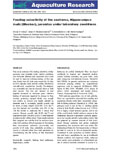Feeding selectivity of the seahorse, Hippocampus kuda (Bleeker), juveniles under laboratory conditions

View/Open
Date
2012Page views
435Metadata
Show full item recordCited times in Scopus
- Citations
- CrossRef - Citation Indexes: 17
- Scopus - Citation Indexes: 29
- Captures
- Mendeley - Readers: 55
Share
Abstract
This study examined the feeding selectivity of Hippocampus kuda juveniles under captive conditions and evaluates different food organisms that could be used to improve hatchery-rearing of this species. Newly born H. kuda were reared for 10 days in 60-L capacity tanks and fed rotifers (Brachionus rotundiformis), zooplankton (mostly Pseudodiaptomus annandalei and Acartia tsuensis) alone or both food sources. The size and amount of food ingested increased as seahorses grew. Selective feeding of seahorses appeared to change as they develop, preferring copepod adults over nauplii and rotifers. A. tsuensis was highly selected by juveniles over P. annandalei. Specific growth rate in terms of body weight (SGR-BW, 15% day–1) was the highest and mortality rate (9% at day 10) the lowest in seahorses fed a mixed food sources. Slowest growth rate (0.3% day–1) and highest mortality rate (60% at day 7) were observed in seahorses fed rotifers alone. These results indicate that copepods are suitable food for seahorse juveniles, but a mixture of food organisms in the rearing tank environment enhances survivorship and growth of H. kuda, thus potentially providing a source of cultured rather than wild specimens for characterizing the life history of this threatened species.
Suggested Citation
Celino, F. T., Hilomen-Garcia, G. V., & del Norte-Campos, A. G. C. (2012). Feeding selectivity of the seahorse, Hippocampus kuda (Bleeker), juveniles under laboratory conditions. Aquaculture Research , 43(12), 1804-1815. https://doi.org/10.1111/j.1365-2109.2011.02988.x
Subject
Taxonomic term
Collections
- AQD Journal Articles [1248]

